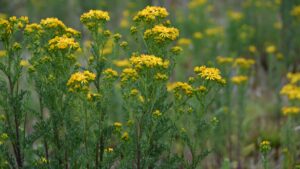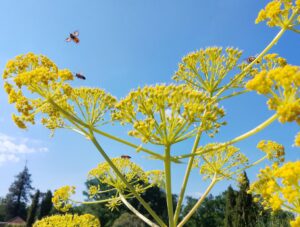
Podcast Episode 36 – The Dove From Above
PODCAST EPISODE 36: The Dove From Above Join us on a beautiful June evening for episode 36 of the Knepp Wildland Podcast. We’re joined by
Home / The Journey to Wilding the Garden ~ May 2022
The first of May is the festival of Beltane. The word comes from the Celtic ‘bel’ meaning ‘the bright one’ and the Gaelic for fire (teine). It marks the coming of summer and rising fertility. The flames represent the energy of the sun. In Knepp’s hedgerows, frothy heads of cow parsley crowd under cascades of hawthorn blossom, and in the orchard the apple trees’ perfect white petals stand out against the unparalleled fresh green of spring.
However, we have noticed how much earlier flowers seem to appear. A study from Cambridge University this year has shown that plants are flowering a full month early as the UK climate heats up. Using records dating from the mid-eighteenth century to 1986 the research team studied 406 species of trees, shrubs and herbaceous plants, then documented the changes from 1987 until 2019. This period coincides with the acceleration of global warming through human activity and prompts concerns about ‘ecological mismatch.’ This is where species which synchronise their migration or hibernation with the timings of other species may be left without the plants and conditions they have evolved to rely on if they cannot adapt quickly enough.
We’re hoping to support biodiversity in the rewilded Walled Garden by providing a greater diversity of plants than is commonly found in the wider landscape. This will provide vital food supplies for insects and birds both early and late in the year, filling those hungry gaps.
We were sad to see that our Bee Kind hive in the Kitchen Garden has not shown any signs of activity so far this year. Perhaps the last of the swarms simply moved elsewhere last autumn, or possibly the bees were affected when Storm Eunice blew the thatched roof off back in February. Ecologists are concerned that the vogue for beekeeping for honey, particularly in cities, is producing huge populations of non-native honeybees which outcompete our 250 or so species of native solitary bees and other pollinators. In the wider rewilding project at Knepp we limit the number of beehives to twenty-six. We definitely won’t be keeping bees for honey in the garden. But there is a need to encourage colonies of wild honeybees. Wild bees nest in hollow trees. They need cavities with a circumference between forty and sixty centimetres– way bigger than the hole a woodpecker excavates. The obsession with chopping down all standing dead trees in the landscape over the past few centuries has deprived wild bees of vital habitat. Our Bee Kind hive, designed by Matt Somerville, provides a place for them.
We contacted Matt to ask him what we should do to attract another swarm into the hive. He directed us to remove the old combs, leaving the top five inches, rub the inside with ground-down lemongrass stalks, and stand the old combs outside, at the base of the hive. Lemongrass has a similar aroma to the hormones of a queen bee and the smell of the beeswax in the combs attracts scouts. We wait to see how soon they’ll come.

Suzi and Charlie remove the old combs from the Bee Kind hive.

Looking up inside the cleared hive.

The removed combs.
On the terrace the lawn is allowed to grow. The established ha-ha meadow is crammed with yellow rattle (Rhinanthus minor) busy parasitising the vigorous grasses and allowing over twenty-five broadleaf species a chance to compete. We’re mowing short pathways to allow easy passage through the swathe and for places to sit amongst the wildflowers. But there are practical considerations, too. Seed from the long grasses strayed into the pebble paths by the house when we scythed at the end of summer last year. By keeping a close-cut narrow strip running beside the path this season we are trying to limit the seeding and consequent weeding. We are also concerned about the rare waxcap fungi which appear in the lawn in October. Generally, they prefer undisturbed mown or cropped grass, so we aim to keep it shorter around the base of the veteran cedars where the fungi are most common. We’ll repeat last year’s August cut of the rest of the meadow as this approach saw their re-emergence in the autumn.
With the help of John and Mina, two of our garden volunteers, we have given the colossal fallen oak between the terrace and the entrance to the walled garden a makeover, encouraged by the occasional squeals from Mina’s bouncing five-month-old son. The aim, here, is to bring the sculptural outline of the crown into focus by removing the dead brash and clearing snagging branches. Now you can see the beautiful, deeply fissured bark, lichens and mosses up close. We hope this might encourage people to consider a similar approach to dead wood if a tree falls in their own garden and they have space to leave it.



Above, the garden volunteers tackle the brash of the fallen oak, and below, the cleared limbs.
Mid-month saw the hottest day of the year so far, reaching the mid-twenties, swiftly chased by downpours and lightning storms. With rain almost every day we have had no need to irrigate the seed mixes overlaid onto the Pool Garden’s planting in the crushed concrete and sand substrate. Both Tom Stuart Smith and James Hitchmough chose a selection of plants from dry habitats to include as seeds in their designs. The seeds were broad sown by hand after the majority of the small 9cm pots and bare root plants were planted in November last year. They add another layer of complexity as well as fill gaps between plants that might be colonised by ‘pernicious’ weeds such as nettles or dock, that can quickly set up shop and elbow out their competitors. All any gardeners talk of at this time of year is how fast the ‘weeds’ (or are they native wildflowers?) grow. In our kaleidoscope of conditions in the garden we see how the plants, including ‘weeds’, respond to the allocation of resources. In the shadier, moist, nutrient-rich bed that runs all along the stable yard wall in the Kitchen Garden, growth is swift and lush, giving us the feeling that we could sit and watch leaves and shoots expand before our eyes. But the consequence of this environment is that those plants that grow largest and fastest outcompete any smaller, slower-growing species. Nettles, docks, milk thistles and black bryony, exert their innate competitive edge, reaching bullish, knee-high proportions in a matter of days.
This bed in the productive side of the garden is undoubtedly full, but with fewer plant species per cubic metre compared to the other end of the spectrum in the Pool Garden. Here the ridges and bowls of the free-draining, nutrient-poor substrate reduces the availability of resources and levels out the competition. The same area can provide for many more species. Of course, the opposite applies to below-ground diversity. Microorganisms, bacteria and fungi, as well as larger soil-dwelling animals such as the worms that feed off them, are all serviced by plants. The more abundant growth in the Stable Yard bed at the top of the Vegetable Garden means more plant roots releasing sugars into the soil, feeding the biota, compared to the sparser growth in the dry Pool Garden. Added to this is the nutrient density of the dark and rich soil itself, repeatedly having organic matter added to it. We’ll continue to sample the soils in both areas and see how the soil biodiversity develops.
Admittedly, we are still in the initial stages of establishment. Most of the planting has only been in the ground since November. As the plants mature, however, we will observe what happens – how some plants may dominate or colonise other areas, how some may fail. We will experiment by opening up areas, cutting back or removing plants, or collecting and spreading seed when we think the garden needs it – when a tipping point has been reached and the variety of plants is beginning to decline.
Latent ‘weed’ seeds have sprung up from the concrete mix in response to the warmer air and the rains, but they are very much easier to spot and smaller specimens than those in the Stable Yard bed. Some of them are welcome. Fumitory (Fumaria officinallis), chickweed (Stellaria media) and scarlet pimpernel (Anagalis arvensis) – all ‘arable weeds’ now in stark decline – may one day provide seeds for turtle doves visiting the garden from the rewilding project.


Scarlet pimpernel and fumitory in the crushed concrete and sand of the Pool Garden
But we’re removing more thuggish ‘weeds’, such as nettles, annual grasses, willow herb and fleabane, to help the sown seed to establish.
It is already easy to see how the areas of xeric, poor soil-loving plants in this mosaic design will help the garden rise to the challenge of rising temperatures and drier, earlier springs. We hope our approach will also dramatically reduce costs as the price of water, fertilisers and transportation continues to increase. And at the same time, support the inhabitants of the natural world.
Moy Fierheller Deputy Head Gardener May 2022
What we’re reading this month:
UK plants flowering a month earlier due to climate change | University of Cambridge
Flowers arriving a month early in UK as climate heats up | Wild flowers | The Guardian
UK Butterflies – Larval Foodplants
Provisional checklist of European butterfly larval foodplants (pensoft.net)

PODCAST EPISODE 36: The Dove From Above Join us on a beautiful June evening for episode 36 of the Knepp Wildland Podcast. We’re joined by

Matt Phelps | Lead Ecologist It’s mid-June and the countryside is quietly gearing up for its summer crescendo. You might have noticed it already— what

Moy Fierheller | Deputy Head Gardener Visit Knepp’s rewilded Walled Garden The fine, fairy-tale spring continues and the Met Office reports it’s the sunniest in
Knepp Wildland Safaris, our gardens and campsite are all about the quiet and patient observation of nature.
Some of the species we are likely to encounter are shy or can be frightened by loud noises or sudden movements. Our campsite with open-air fire-pits, wood-burning stoves and an on-site pond is unsuitable for small children.
For this reason, our safaris, garden visits, holiday cottages and campsite are suitable only for children of 12 and over.